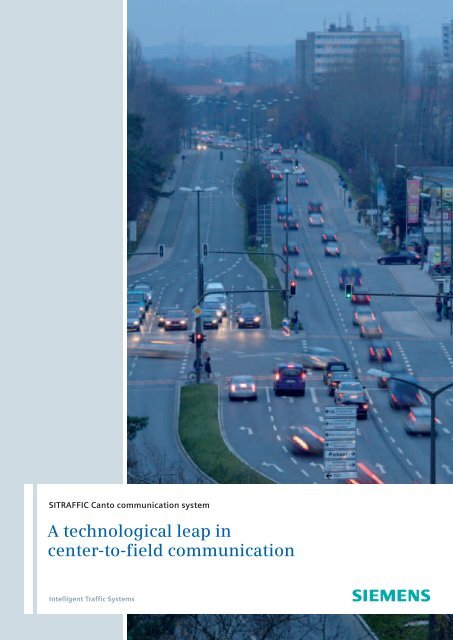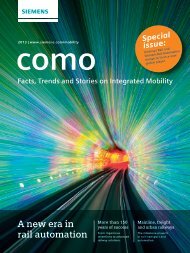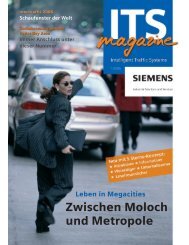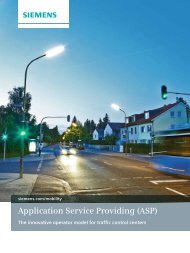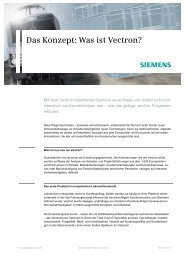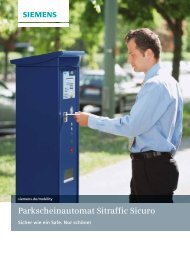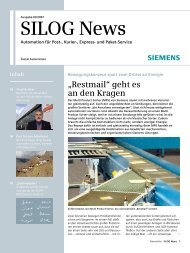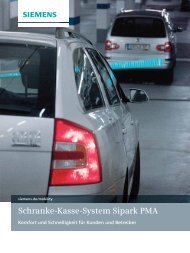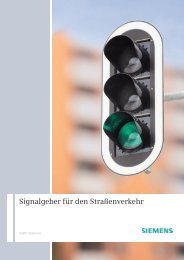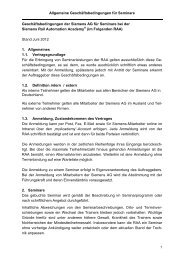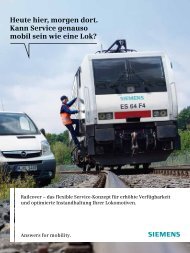SITRAFFIC Canto - Siemens Mobility
SITRAFFIC Canto - Siemens Mobility
SITRAFFIC Canto - Siemens Mobility
Create successful ePaper yourself
Turn your PDF publications into a flip-book with our unique Google optimized e-Paper software.
<strong>SITRAFFIC</strong> <strong>Canto</strong> communication system<br />
A technological leap in<br />
center-to-field communication<br />
Intelligent Traffic Systems
2<br />
<strong>SITRAFFIC</strong> <strong>Canto</strong>:<br />
Take advantage of all the benefits<br />
of a future-oriented technology –<br />
with your existing equipment!<br />
<strong>SITRAFFIC</strong>® <strong>Canto</strong>, the new communication system, offers today’s most advanced<br />
communication technology for application in a traffic control engineering context.<br />
<strong>Canto</strong> stands for “Communication in advanced new technology in outstations.”<br />
The system enables continued use of your existing traffic controller installations,<br />
including those that still conform to the BEFA 5 standard, while creating the basis<br />
for using modern technologies such as DSL, OTN, fiber optic cable, etc. It also<br />
allows the seamless combination of conventional copper cables and new communi-<br />
cation networks.
Latest technology for<br />
center-to-field communication<br />
Optimum traffic management in today’s<br />
world requires high-performance data links<br />
between intersections and the control<br />
center for very fast data exchange and<br />
frequently also for the parallel transmission<br />
of very large quantities of data to multiple<br />
recipients. With <strong>SITRAFFIC</strong> <strong>Canto</strong> you<br />
can benefit from all modern transmission<br />
technologies: fiber optic cable, LAN,<br />
OTN, mobile radio links and Internet connections.<br />
Now you can connect far more<br />
traffic signal installations to a single<br />
wire pair than ever. This gives you a maximum<br />
of communication capacity – at<br />
lower costs.<br />
Smooth migration from BEFA<br />
to <strong>Canto</strong><br />
New communication technologies usually<br />
go hand in hand with high extra costs<br />
because they tend to require new terminal<br />
devices. With <strong>SITRAFFIC</strong> <strong>Canto</strong>, existing<br />
traffic control equipment in the field is<br />
anything but “scrap metal”! When developing<br />
the new communication system we<br />
have made sure that you will be able to<br />
continue to use your existing equipment.<br />
So there is no contradiction between<br />
installing a new control center and keeping<br />
time-tested outstations.<br />
<strong>SITRAFFIC</strong> Scala<br />
Control center<br />
Outstations Access Point (OAP)<br />
<strong>SITRAFFIC</strong> <strong>Canto</strong> BEFA<br />
<strong>SITRAFFIC</strong><br />
C900V, C800V*<br />
System boundary<br />
*<strong>SITRAFFIC</strong> C800V upgraded to C900V<br />
MPM-C<br />
<strong>SITRAFFIC</strong> C800XS,<br />
M/MS, EFU, GE, MF<br />
The control center and<br />
the traffic controllers<br />
are linked together via<br />
multifunction modules<br />
(MPM-C) that are either<br />
directly integrated<br />
or installed upstream<br />
NCOM XKOM<br />
MPM-C<br />
Device from other<br />
manufacturers<br />
3
The traffic computer<br />
must have sufficient<br />
capacity for fast<br />
and reliable control<br />
of even widely<br />
branching traffic<br />
nodes. <strong>SITRAFFIC</strong><br />
<strong>Canto</strong> provides<br />
everything you need<br />
for these control<br />
tasks<br />
Traffic controllers<br />
such as the<br />
<strong>SITRAFFIC</strong> C900<br />
are already fully<br />
equipped for modern<br />
communication.<br />
For (practically) all<br />
other types, the<br />
MPM-C adaptation<br />
module is all that’s<br />
needed<br />
<strong>SITRAFFIC</strong> <strong>Canto</strong><br />
can also communicate<br />
via fiber optic<br />
cable networks<br />
4
<strong>SITRAFFIC</strong> <strong>Canto</strong>:<br />
A flexible answer to your needs that<br />
uses the installed technology base<br />
V.34/PPP dedicated line operation:<br />
the ideal solution for existing cabling<br />
When? Whenever your upgrade plans<br />
call for direct migration from BEFA to<br />
<strong>SITRAFFIC</strong> <strong>Canto</strong> and the use of an existing<br />
cable link, this is the best connection<br />
option.<br />
How? A point-to-point link between the<br />
control center and the traffic controller<br />
is set up via modem. The connection is<br />
established via PPP using the TCP/IP protocol;<br />
on good-quality lines the maximum<br />
transfer rate is 28.8 kbit/s.<br />
Advantages: In dedicated line operation,<br />
the switch from BEFA 5, 8, 12, 15 (17)<br />
to <strong>Canto</strong> is mostly unproblematic and<br />
straightforward. The connection is adequate<br />
for transmission of process and<br />
control data (raw and aggregated data).<br />
Dedicated line operation via<br />
Ethernet: DSL or fiber optic cable –<br />
whatever you need<br />
When? Whenever the system layout<br />
requires networked operation of local<br />
controllers and a high data throughput,<br />
and an existing Ethernet ring (LAN) is<br />
available, this is the optimum type of<br />
dedicated line operation for <strong>SITRAFFIC</strong><br />
<strong>Canto</strong>.<br />
How? The local controllers and the<br />
control center each have a direct Ethernet<br />
link; the distances in-between are<br />
bridged by as DSL (i.e. copper) or fiber<br />
optic cable connections. In case some local<br />
controllers are located more than 150<br />
meters from the fiber optic cable line,<br />
DSL lines and fiber optic cables can also<br />
be used in combination.<br />
DSL advantages: Compared to a V.34<br />
connection, DSL offers a many times higher<br />
data throughput, enabling fast remote<br />
configuration and control (remote access,<br />
etc.). This significantly lowers control<br />
center hardware costs (as the customary<br />
modem cabinet is not needed anymore),<br />
reduces line lengths and thus maintenance<br />
expenses, and enables the use of the<br />
installed communication infrastructure for<br />
traffic monitoring and detection purposes.<br />
Fiber optic cable advantages: The benefits<br />
of fiber optic cable connections include,<br />
in addition, extremely high data throughputs<br />
(up to 1 Gbit), zero susceptibility<br />
to electromagnetic interference, and an<br />
extremely long lifetime, which ensures<br />
highly favorable total lifecycle costs for<br />
the investment.<br />
A first: <strong>SITRAFFIC</strong> <strong>Canto</strong>-G (GPRS),<br />
a wireless connection used as “<br />
dedicated line”!<br />
GPRS is based on the GSM standard with<br />
special focus on faster data transmission.<br />
Throughout central Europe, this format<br />
offers close to 100 percent coverage.<br />
The special advantage of this technology:<br />
Control centers no longer need to be<br />
equipped with radio technology; highbandwidth<br />
Internet access is absolutely<br />
sufficient. This opens the door to a quasidedicated<br />
line for which fees are payable<br />
not on the connection time but on the<br />
data quantity transferred. In comparison<br />
to GSM connections, this results in considerably<br />
lower operating and hardware costs.<br />
Since this cost-effective connection type<br />
uses an Internet link, data security has<br />
top priority. The required high degree of<br />
security has been built right into <strong>SITRAFFIC</strong><br />
<strong>Canto</strong>: connections are established via<br />
VPN and therefore comply with the highest<br />
encryption standards, comparable with<br />
the security levels generally implemented<br />
in Internet banking.<br />
5
6<br />
V.34 PPP dedicated line operation<br />
Control center V34 modem V34 modem<br />
Local controller<br />
Operation via Ethernet<br />
Control center<br />
(IG)<br />
Customer<br />
ETHERNET<br />
Use of fiber optic cables<br />
Control center<br />
(IG)<br />
<strong>SITRAFFIC</strong> <strong>Canto</strong>-G/GPRS profile (prospective stage 2 layout)<br />
Control center<br />
(IG)<br />
PPP<br />
LAN LAN<br />
LAN<br />
Media<br />
converter<br />
DSL<br />
multiplexer<br />
2 - 4 km<br />
„Last Mile”<br />
DSL modem<br />
1 to X<br />
max. 1 m<br />
LAN LAN<br />
DSL modem<br />
with firewall<br />
Fiber optic<br />
cable link<br />
Internet<br />
and GPRS<br />
Media converter or<br />
fiber optic cable switch<br />
LAN RS232<br />
GPRS<br />
terminal<br />
Local controller<br />
Local controller<br />
<strong>SITRAFFIC</strong><br />
<strong>Canto</strong> unit<br />
Dedicated line<br />
operation via V.34<br />
interface and<br />
PPP/TCP/IP protocol:<br />
the ideal solution<br />
for existing cabling<br />
in all cases where<br />
relatively low data<br />
transmission capacity<br />
is adequate<br />
Dedicated line<br />
operation via<br />
Ethernet/DSL link:<br />
several times faster<br />
than a V.34 link and<br />
no need for modem<br />
cabinet<br />
Dedicated line<br />
operation via<br />
Ethernet/fiber optic<br />
cable link: speeds<br />
of up to 1Gbit/s and<br />
zero susceptibility<br />
to electromagnetic<br />
interference<br />
Advantageous<br />
“quasi-dedicated”<br />
line via GPRS<br />
profile and Internet:<br />
an innovation in<br />
center-to-field<br />
communication
<strong>SITRAFFIC</strong> <strong>Canto</strong>:<br />
Unprecedented performance –<br />
and cost-effectiveness – in<br />
center-to-field communication!<br />
<strong>SITRAFFIC</strong> <strong>Canto</strong> represents a giant leap forward, in both technological and economical<br />
terms. Instead of proprietary modules, high-quality standard components are now<br />
being deployed in the traffic control arena. Standard components that really deliver the<br />
goods: packed with new functionalities, they significantly outperform traditional solutions<br />
and, for the first time, allow central control of traffic intersections trough wireless<br />
links and public networks. It all makes for a far more economical system solution than<br />
today’s conventional technologies.<br />
Much higher transmission capacity<br />
Compared to the old BEFA landscape,<br />
the new <strong>Canto</strong> world means vastly<br />
improved data transmission performance.<br />
The transmission capacity provided by<br />
the “Partyline” function, for instance, is<br />
several times higher than that of BEFA<br />
16 systems, thus enabling connection<br />
of up to 32 traffic signal installations to<br />
a single wire pair. The previous limit<br />
stood at 8 or 16 installations per line!<br />
Agreeably economical communication<br />
via public networks<br />
<strong>SITRAFFIC</strong> <strong>Canto</strong> enables the use of<br />
public networks (GPRS) for center-to-field<br />
communication. Thus multiple intersections<br />
can be controlled simultaneously, and<br />
cost-effective “dedicated lines” can be<br />
established so that it’s the quantity of data<br />
transmitted, rather than the connection<br />
time, that determines the costs. Not only<br />
is it possible to stay permanently online,<br />
it also makes the most sense to combine<br />
the high availability of a physical line with<br />
the benefits of a wireless link.<br />
Encryption for total security<br />
To enable the use of public networks,<br />
the encryption level we have built into<br />
<strong>SITRAFFIC</strong> <strong>Canto</strong> matches the high<br />
levels customary in Internet banking.<br />
This ensures that access is only available<br />
to authorized maintenance staff.<br />
Amazingly compact new central<br />
modem hardware<br />
<strong>SITRAFFIC</strong> <strong>Canto</strong> keeps a low profile<br />
in the control center: the new modem<br />
hardware occupies just a quarter of<br />
the space needed by previous models,<br />
so that each rack can accommodate<br />
64 modems instead of 16.<br />
Below you will find details of the communication profiles that can be used with <strong>SITRAFFIC</strong> <strong>Canto</strong>.<br />
7
The MPM-C control<br />
unit (top) allows<br />
even the integration<br />
of rather old devices<br />
into <strong>SITRAFFIC</strong> <strong>Canto</strong>.<br />
The ZMA-M1 quadruple<br />
control center<br />
modem (bottom)<br />
establishes the link<br />
with the traffic<br />
controllers<br />
8<br />
Infrastructure is expensive.<br />
We’ll make sure that you<br />
can use it for as long as possible<br />
The pace of innovation in the field of transport engineering increases by the day.<br />
So the biggest challenge is to benefit intelligently from new developments while assuring<br />
the best possible investment security for already installed assets. <strong>Siemens</strong> has long<br />
been known for managing this difficult situation in such a way that customers can rely<br />
on maximum long-term protection for their investments. Our innovations in the area<br />
of traffic computers and control systems have always been based on efficient migration<br />
strategies that offer economic advantages to the customer. And the <strong>SITRAFFIC</strong> <strong>Canto</strong><br />
communication system is no exception.<br />
<strong>Siemens</strong> transmission technology<br />
that can be integrated<br />
in <strong>SITRAFFIC</strong> <strong>Canto</strong>:<br />
BEFA 5/6 from 1974<br />
BEFA 7 from 1974<br />
BEFA 8 from 1978<br />
BEFA 12 from 1984<br />
BEFA 15 from 1984<br />
BEFA 16 from 1996<br />
BEFA 17 from 1997<br />
<strong>Siemens</strong> traffic controllers<br />
that can be integrated in<br />
<strong>SITRAFFIC</strong> <strong>Canto</strong>:<br />
GE from 1975<br />
M32 from 1976<br />
ML/MF/MQ from 1983<br />
MK/MS from 1987<br />
MP/MSP from 1990<br />
MR from 1995<br />
<strong>SITRAFFIC</strong> C800* from 1999<br />
<strong>SITRAFFIC</strong> C900 from 2006<br />
*when upgraded to C900
Valuable assets: traffic controllers<br />
of practically all generations ...<br />
Based on a common networking infrastructure,<br />
nearly all the traffic control<br />
devices installed in the field today can be<br />
operated using the new communication<br />
system: modern <strong>SITRAFFIC</strong> C900 units<br />
as well as older devices such as GE, MF,<br />
FU M32, EFU, MP, MQ, MR, MS – right back<br />
to controllers dating from 1975! Traffic<br />
controllers of the <strong>SITRAFFIC</strong> C800 range<br />
can easily be upgraded to C900 by installing<br />
a <strong>Canto</strong> module – a very simple option<br />
for modernizing field equipment. <strong>Canto</strong><br />
supports all systems except those with<br />
signal group remote control.<br />
...and IP-based<br />
communication networks<br />
The new system is based on the TCP/IP<br />
transmission protocol. Wherever there are<br />
existing communication networks that<br />
use this protocol (e.g. OTN networks), it is<br />
especially easy and economical to put<br />
<strong>SITRAFFIC</strong> <strong>Canto</strong> into action.<br />
9
For further information,<br />
please contact:<br />
<strong>Siemens</strong> AG<br />
Industrial Solutions and Services<br />
Intelligent Traffic Systems<br />
I&S ITS<br />
Hofmannstrasse 51<br />
D-81359 Munich<br />
The information contained in this brochure<br />
comprises only general descriptions and<br />
performance features of products and<br />
systems, which may not always apply<br />
exactly as described in every realized<br />
application or which may be subject to<br />
change due to further development of the<br />
products described. Performance features<br />
are only to be considered binding if they<br />
have been explicitly agreed in the contract.<br />
© <strong>Siemens</strong> AG 2007<br />
All rights reserved<br />
<strong>SITRAFFIC</strong>® is a registered trademark of <strong>Siemens</strong> AG<br />
www.siemens.de/traffic<br />
Order No.: E10003-A800-A38-V1-7600<br />
Printed in Germany<br />
Dispo No.: 22300 K-No.: 40100<br />
DEI C-TSRT5207M15 WS 02073.<br />
The information contained in this document<br />
is subject to change without notice.


